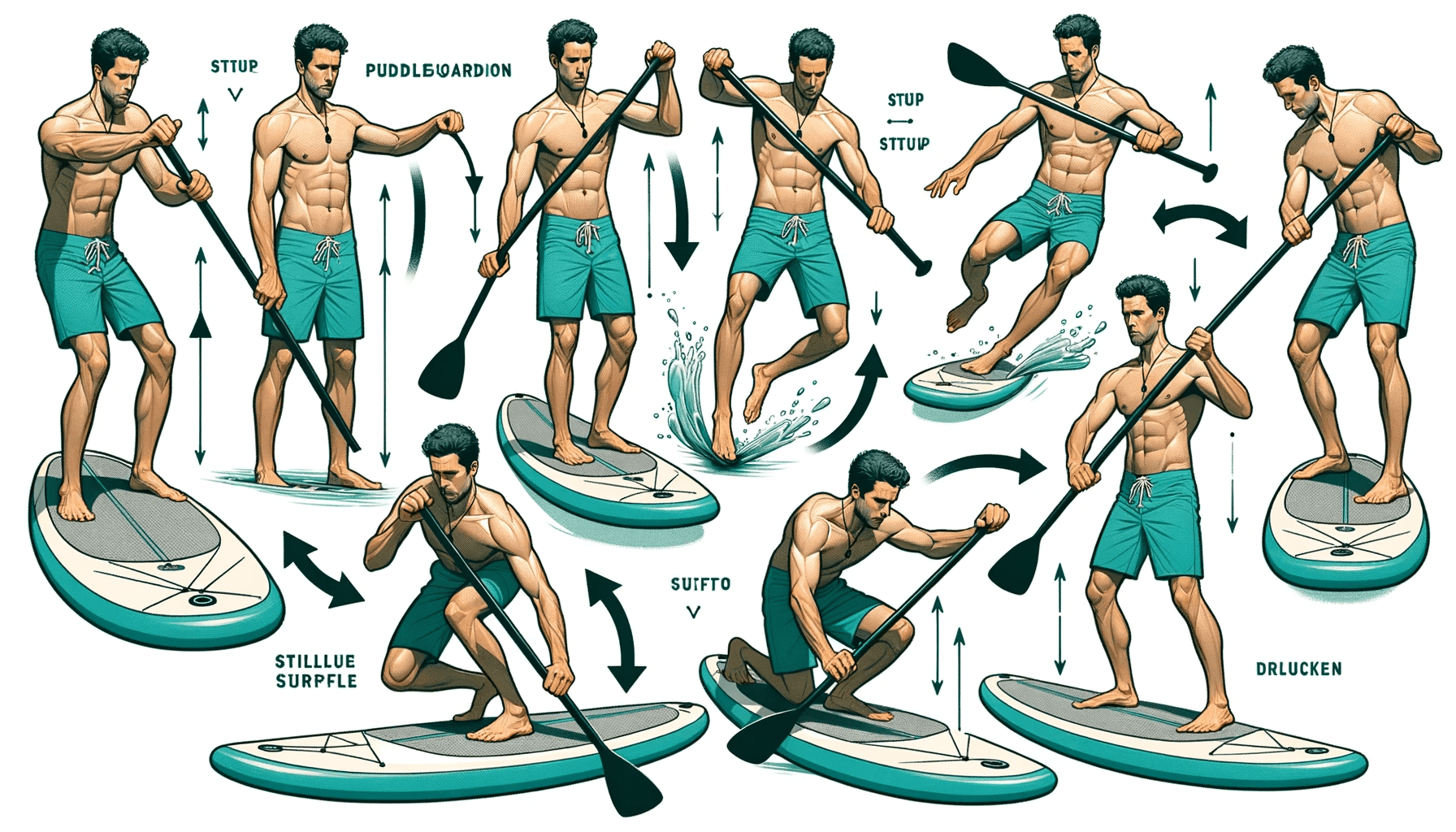Imagine gliding across the ocean’s surface, feeling the rhythm of the waves beneath you. Ocean paddleboarding is like dancing on water, providing a full-body workout that engages muscles from head to toe.
Not only does it improve core strength and cardiovascular endurance, but it also enhances balance and stability. With its low-impact nature, paddleboarding offers a refreshing way to stay fit without putting excessive strain on joints.
Dive into this exhilarating activity and discover the many fitness benefits it has to offer.
Full-Body Workout
Ocean paddleboarding provides a comprehensive full-body workout. This water sport engages multiple muscle groups, resulting in improved muscle tone and increased calorie burning. When paddleboarding, the core muscles, including the abs and lower back, are constantly engaged to maintain balance and stability on the board. The legs work to maintain a steady stance and provide power for propelling forward through the water. Additionally, the arms, shoulders, and back muscles are utilized to paddle and steer the board.
The constant movement and resistance from the water make paddleboarding a highly effective exercise for toning and strengthening the entire body. Unlike traditional workouts that isolate specific muscle groups, paddleboarding engages the entire body in a dynamic and functional way. This not only promotes balanced muscle development but also improves overall stability and coordination.
Furthermore, paddleboarding is a great way to burn calories. According to research, an hour of moderate paddleboarding can burn around 500-700 calories. The combination of aerobic and strength-building elements in this activity makes it an efficient calorie-burning exercise. Moreover, the serene and enjoyable nature of paddleboarding can often make it feel less like a tedious workout and more like a fun adventure on the water.
Improved Core Strength
Improving core strength is a key benefit of ocean paddleboarding. Paddleboarding requires engaging your core muscles to maintain balance and stability while maneuvering through the water. The constant shifting of your body weight and the resistance of the water provide an excellent workout for your core muscles, including your abdominals, obliques, lower back, and glutes.
When you paddleboard, your core muscles work together to keep you balanced on the board. This not only strengthens your core but also improves your balance and stability. As you paddle, your core muscles stabilize your body and help you maintain an upright posture, preventing you from falling into the water. This constant engagement of your core muscles during paddleboarding can lead to improved balance not only on the board but also in other areas of your life.
Additionally, paddleboarding can help increase muscle tone in your core. The act of paddling requires repetitive movements that target the muscles in your abdomen and lower back, helping to sculpt and define them. As you paddle, the resistance provided by the water adds an extra challenge, making your core muscles work harder and promoting muscle growth and toning.
In summary, ocean paddleboarding is an effective way to improve core strength, balance, and muscle tone. By engaging your core muscles during each paddle stroke, you can strengthen your abdominals, obliques, lower back, and glutes. Furthermore, the constant shifting of your body weight and the resistance of the water provide an excellent workout for your core, leading to improved balance and increased muscle tone.
Increased Cardiovascular Endurance
Ocean paddleboarding isn’t just a fun activity, but it also offers numerous fitness benefits.
One of these benefits is increased cardiovascular endurance. Engaging in this water sport requires constant paddling, which raises the heart rate and improves heart health.
Additionally, the repetitive movements of paddleboarding help enhance stamina levels and increase lung capacity, leading to improved overall cardiovascular fitness.
Improved Heart Health
Paddleboarding in the ocean enhances cardiovascular endurance, promoting improved heart health. Engaging in this activity regularly can have several benefits for the heart. Here are some ways that paddleboarding can contribute to improved heart health:
- Improved Blood Circulation: Paddleboarding involves constant movement and engagement of the upper body muscles. This helps to improve blood flow throughout the body, including to the heart. Better blood circulation allows the heart to function more efficiently.
- Reduced Risk of Heart Disease: Regular paddleboarding can help to reduce the risk of heart disease. It’s a form of aerobic exercise that strengthens the heart muscle and lowers blood pressure. These factors play a crucial role in preventing heart disease.
- Increased Cardiovascular Endurance: Paddleboarding is a low-impact exercise that can improve cardiovascular endurance. It challenges the heart to work harder and adapt to increased demands, leading to enhanced stamina levels.
Enhanced Stamina Levels
Regularly engaging in ocean paddleboarding can significantly increase an individual’s stamina levels, improving their cardiovascular endurance. Paddleboarding requires constant paddling and balancing, which engages multiple muscle groups and increases heart rate. As a result, the cardiovascular system works harder to deliver oxygen and nutrients to the muscles, leading to improved endurance and better physical performance.
Studies have shown that paddleboarding can be an effective aerobic exercise, with participants experiencing increased lung capacity and lower resting heart rates. This enhanced cardiovascular endurance allows individuals to sustain physical activity for longer periods without experiencing fatigue or shortness of breath. It also improves their ability to recover quickly during and after intense exercise.
Moreover, ocean paddleboarding provides a dynamic and engaging workout that can be tailored to individual fitness levels and goals. Whether it’s leisurely paddling along the shore or challenging oneself with more intense sessions, the constant movement and resistance of the water provide a stimulating and invigorating experience.
Increased Lung Capacity
Engaging in ocean paddleboarding can lead to an increase in an individual’s lung capacity and overall cardiovascular endurance. This popular water sport requires constant paddling, which involves a combination of upper body and core strength as well as sustained aerobic activity. As a result, the respiratory system is continuously challenged, leading to improved respiratory function and enhanced lung capacity.
Here are some key benefits of ocean paddleboarding for increased lung capacity:
- Increased tidal volume: Regular paddleboarding encourages deeper and more controlled breathing, which helps to expand the lungs and increase the amount of air taken in with each breath.
- Improved oxygen uptake: The increased demand for oxygen during paddleboarding forces the body to become more efficient at extracting and utilizing oxygen, leading to improved cardiovascular endurance.
- Strengthened respiratory muscles: Paddleboarding engages the muscles involved in respiration, such as the diaphragm and intercostal muscles, leading to increased strength and endurance.
- Enhanced overall fitness: By engaging in ocean paddleboarding regularly, individuals can greatly improve their cardiovascular fitness levels, leading to improved lung capacity and endurance.
Enhanced Balance and Stability
Enhanced balance and stability are key benefits of ocean paddleboarding.
By standing on the board and using the paddle to navigate through the water, individuals engage their core muscles, which leads to improved core strength.
Additionally, the constant adjustments required to maintain balance on the water provide a full-body workout, as multiple muscle groups are activated to keep the individual stable and upright.
Core Strength Improvement
Paddleboarding in the ocean can improve core strength by increasing balance and stability. When a person stands on a paddleboard, their core muscles engage to maintain balance on the unstable surface of the water. This constant engagement of the core muscles helps to strengthen and tone them over time.
The benefits of core strength improvement through paddleboarding include:
- Improved posture: Having a strong core helps to support the spine and maintain proper alignment, leading to improved posture both on and off the paddleboard.
- Injury prevention: A strong core provides stability and support to the entire body, reducing the risk of injuries during physical activities.
- Increased balance: By constantly engaging the core muscles to maintain balance on the paddleboard, paddleboarders can improve their overall balance and stability.
- Enhanced stability: A strong core provides a stable foundation for the body, allowing paddleboarders to navigate the ocean waves with greater stability and control.
Engaging in ocean paddleboarding regularly can lead to significant improvements in core strength, resulting in better posture, injury prevention, increased balance, and enhanced stability.
Full Body Workout
Ocean paddleboarding provides a full body workout, improving balance and stability throughout the entire body. This activity engages muscles in the arms, shoulders, back, and core as you paddle through the water. The constant balancing required on the board activates the muscles in your legs, hips, and glutes, helping to improve overall stability.
In addition to building strength, paddleboarding also enhances flexibility. The movements involved in paddling require a wide range of motion, stretching and lengthening the muscles. This increased flexibility can lead to improved posture and reduced risk of injury.
Furthermore, paddleboarding can be an effective way to burn calories. The combination of paddling and maintaining balance on the board can provide a challenging cardiovascular workout, helping to shed excess pounds and improve overall fitness.
Low-Impact Exercise
With ocean paddleboarding, individuals can engage in a form of low-impact exercise that provides numerous fitness benefits. This type of exercise is gentle on the joints, making it an ideal option for those who want to improve their joint health without putting excessive strain on their bodies. Unlike high-impact exercises like running or jumping, paddleboarding allows individuals to work out without causing unnecessary stress on their knees, ankles, and hips.
Benefits of low-impact exercise through ocean paddleboarding include:
- Improved joint health: Paddleboarding helps to strengthen the muscles surrounding the joints, providing support and stability. This can help reduce the risk of joint injuries and improve overall joint function.
- Calorie burn: While paddleboarding may not be as intense as some other forms of exercise, it still provides a great calorie-burning workout. A leisurely paddleboarding session can burn around 300-500 calories per hour, depending on factors such as weight and intensity.
- Increased core strength: Balancing on the paddleboard requires engaging the core muscles, which helps to strengthen and tone them over time.
- Enhanced mental well-being: Being out on the open water, surrounded by nature, can have a calming and therapeutic effect on the mind. Paddleboarding allows individuals to enjoy a sense of freedom and escape from the stresses of daily life.
Stress Relief and Mental Well-Being
Engaging in ocean paddleboarding can provide individuals with stress relief and improved mental well-being. The mind-body connection is a powerful aspect of this activity, as it allows people to connect with nature and their own bodies in a unique way. Paddleboarding requires focus and concentration, which can help individuals to quiet their minds and let go of stress and worries.
Psychological benefits of ocean paddleboarding have been studied and documented. Research has shown that spending time on the water and engaging in physical activity can reduce symptoms of anxiety and depression. The rhythmic motion of paddling, combined with the calming effects of being in nature, can help to regulate emotions and promote a sense of well-being.
In addition, paddleboarding provides an opportunity for mindfulness and meditation. The peacefulness of the ocean, the sound of the waves, and the sensation of gliding across the water can all contribute to a state of relaxation and tranquility. This can help individuals to clear their minds, reduce mental fatigue, and improve overall mental clarity.
Overall, ocean paddleboarding offers a unique and effective way to relieve stress and improve mental well-being. By tapping into the mind-body connection and enjoying the psychological benefits of being on the water, individuals can find a sense of peace and rejuvenation.
Fun and Enjoyable Fitness Activity
Paddleboarding in the ocean isn’t only a stress-relieving and mentally rejuvenating activity, but it also offers a fun and enjoyable way to stay fit. Water sports enthusiasts and those seeking outdoor adventure can find great satisfaction in paddleboarding.
Here are four reasons why paddleboarding in the ocean is a fun and enjoyable fitness activity:
- Full-body workout: Paddleboarding engages your entire body, from your arms and shoulders to your core and legs. Balancing on the board requires constant adjustments, which helps improve your stability and strengthens your muscles.
- Scenic views: Exploring the ocean on a paddleboard allows you to take in breathtaking views of the surrounding nature. Whether it’s the calmness of a sunrise or the vibrant colors of a sunset, the beauty of the ocean adds to the enjoyment of the activity.
- Social interaction: Paddleboarding is often done in groups, making it a great way to connect with others who share your love for water sports and outdoor adventure. You can paddle alongside friends, engage in friendly races, or even join paddleboarding clubs and events.
- Sense of freedom: Being out on the water gives you a sense of freedom and escape from the pressures of everyday life. The tranquility of the ocean, combined with the physical activity, can help clear your mind and reduce stress levels.
Paddleboarding in the ocean offers a fun and enjoyable way to stay fit while immersing yourself in the beauty of nature. So grab your board, hit the waves, and experience the thrill of this fantastic outdoor activity.
Frequently Asked Questions
What Kind of Equipment Do I Need for Ocean Paddleboarding?
When ocean paddleboarding, one needs various paddleboard accessories such as a paddle, leash, and life jacket. It is also important to choose a paddleboard from one of the best paddleboard brands for a quality experience.
Can Ocean Paddleboarding Help With Weight Loss?
Ocean paddleboarding, compared to other water sports, can be a great way to improve cardiovascular health. It provides a low-impact, full-body workout that can aid in weight loss and overall fitness.
Is Ocean Paddleboarding Suitable for Beginners?
Ocean paddleboarding is suitable for beginners with a guide to techniques. Common mistakes to avoid include improper paddle grip and poor body positioning. It’s a great way for beginners to enjoy the freedom of the ocean while getting a full-body workout.
How Long Should I Paddleboard to See Fitness Benefits?
Paddleboarding for at least 30 minutes a day can help improve core strength and overall fitness. Whether you’re a beginner or an experienced paddler, implementing proper paddleboard techniques is essential for maximizing these benefits.
Are There Any Safety Precautions I Should Take While Ocean Paddleboarding?
When it comes to ocean paddleboarding, safety should be a top priority. There are a few key tips to keep in mind, such as wearing a leash, checking weather conditions, and staying aware of your surroundings.


